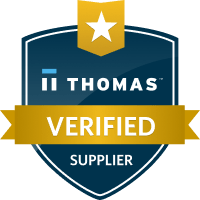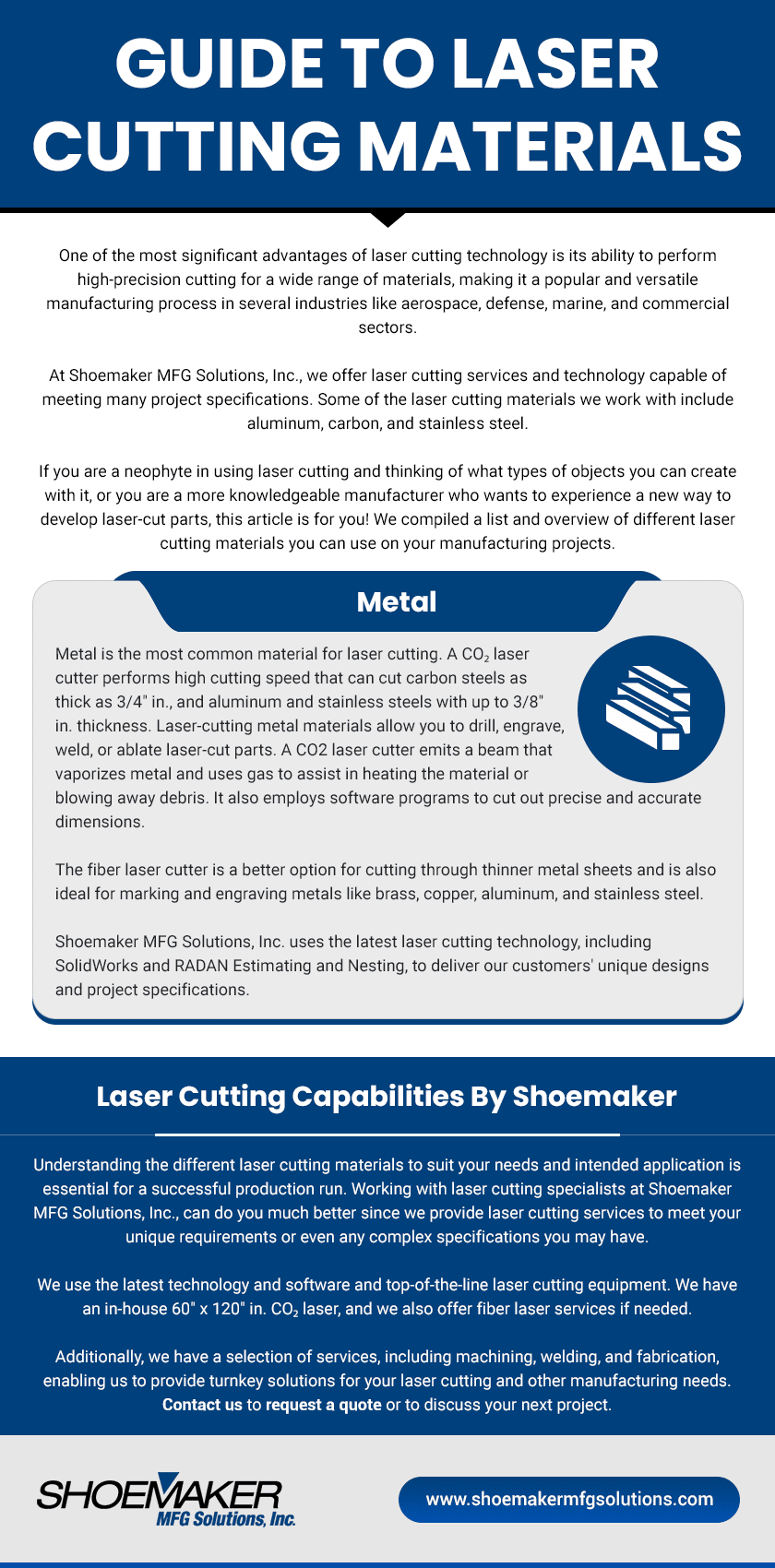Guide Laser Cutting Materials
Comments Off on Guide Laser Cutting MaterialsOne of the most significant advantages of laser cutting technology is its ability to perform high-precision cutting for a wide range of materials, making it a popular and versatile manufacturing process in several industries like aerospace, defense, marine, and commercial sectors.
At Shoemaker MFG Solutions, Inc., we offer laser cutting services and technology capable of meeting many project specifications. Some of the laser cutting materials we work with include aluminum, carbon, and stainless steel.
If you are a neophyte in using laser cutting and thinking of what types of objects you can create with it, or you are a more knowledgeable manufacturer who wants to experience a new way to develop laser-cut parts, this article is for you! We compiled a list and overview of different laser cutting materials you can use on your manufacturing projects.
Metal
Metal is the most common material for laser cutting. A CO₂ laser cutter performs high cutting speed that can cut carbon steels as thick as 3/4″ in., and aluminum and stainless steels with up to 3/8″ in. thickness. Laser-cutting metal materials allow you to drill, engrave, weld, or ablate laser-cut parts. A CO2 laser cutter emits a beam that vaporizes metal and uses gas to assist in heating the material or blowing away debris. It also employs software programs to cut out precise and accurate dimensions.
The fiber laser cutter is a better option for cutting through thinner metal sheets and is also ideal for marking and engraving metals like brass, copper, aluminum, and stainless steel.
Shoemaker MFG Solutions, Inc. uses the latest laser cutting technology, including SolidWorks and RADAN Estimating and Nesting, to deliver our customers’ unique designs and project specifications.
Plastic
The energy of a CO₂ laser beam is easily absorbed by most plastics causing it to heat up and vaporize rapidly, resulting in smooth and straight edges with zero to minimal burn marks. Some examples of common plastic materials used for laser cutting include polyoxymethylene (POM), acrylic or synthetic polymer (PMMA), polyethylene (PE), polyester, and styrene. However, not all types of plastics are ideal for laser cutting as some of them can melt or burn quickly.
Wood
CO₂ laser cutters and engravers are commonly used in creating wood material prototypes or making wooden toys. The typical types of wood used in laser cutting are plywood, bamboo, and MDF (medium-density fiberboard). They are inexpensive, and their thickness can be regulated, which makes them ideal for laser cutting.
Paper & Cardboard
The CO₂ laser’s wavelength is effortlessly absorbed by the paper, which allows for high-precision contours on this material. Laser evaporates paper forms instantly, leaving no smoke or burn residue on the surface. Laser cutting paper is perfect for making individual engravings and decorations for cardboard packaging.
Glass
It may be a seemingly impossible task to laser-cut glass because of its fragile and reflective properties. However, using laser cutters is far more efficient than the traditional ways of cutting this material. A laser cutting machine lowers the chances of horizontal cracks and chipping edges when used in glass. The most common wavelength for cutting glass is 10,600 nm or infrared light from a CO₂ laser. The glass absorbs around 80% of the energy, thus giving that wavelength a solid ability to cut the glass faster and more precisely. However, fiberglass is not applicable for laser cutting because it has epoxy resin that can emit toxic fumes upon contact with lasers.
Foams
While foams may not be as popular as other laser cutting materials, they are an excellent option especially suitable for suitcase inserts, padding, casing, or seals. Popular foam materials used for laser cutting include Depron, EPM, Gator, polyester (PES), polyethylene (PE), polyurethane (PUR), and neoprene. Note that two foam materials are not applicable in laser cutting because they can quickly catch fire – polystyrene and polypropylene foam.
Textiles
Textiles are new materials for laser cutting, particularly in digital embroidery, and it allows for a more efficient and cost-effective embroidery process than its traditional means of production. Since textile was recently used for laser cutting, the range of fabric options is currently limited.
Laser Cutting Capabilities By Shoemaker
Understanding the different laser cutting materials to suit your needs and intended application is essential for a successful production run. Working with laser cutting specialists at Shoemaker MFG Solutions, Inc., can do you much better since we provide laser cutting services to meet your unique requirements or even any complex specifications you may have.
We use the latest technology and software and top-of-the-line laser cutting equipment. We have an in-house 60″ x 120″ in. CO₂ laser, and we also offer fiber laser services if needed.
Additionally, we have a selection of services, including machining, welding, and fabrication, enabling us to provide turnkey solutions for your laser cutting and other manufacturing needs. Contact us to request a quote or to discuss your next project.




